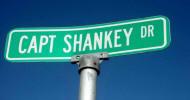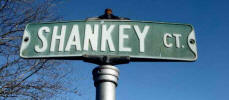
Captain Shankey Drive

Shankey Court
(Photos courtesy 'Dalya)
Although not mentioned in
the article at right, this Captain Shankey Court leads off Shankey Drive
and further honors his name. |
Street Name
Honors WW II Paratrooper
At 9:30 a.m. on June 6, 1944, Supreme Headquarters Allied
Expeditionary Forces, London, England, announced, "Under the
command of General Eisenhower, Allied naval forces supported by
strong air forces began landing Allied armies this morning on
the northern coast of France." It was then 3:30 a.m. on the
eastern seaboard of the United States. As the momentous news was
radioed to the dormant country, lights went on and people
gathered in hushed awe praying for the success of the invasion.
Meanwhile, for the past eight hours widely scattered and
disoriented paratroopers had been fighting and dying in the
hedgerows and floodlands of Normandy. Later that day, President
Roosevelt addressed the nation.
Shortly after World War II the townspeople of Haverstraw in
Rockland County, New York proposed to memorialize its sons who
had perished in combat. Within commuting distance of New York
City the vicinity retains a homespun rural atmosphere. The
returning veterans precipitated a residential construction boom
throughout the country. What would be more appropriate but to
name a street after a paratrooper who fell in the early stage of
the assault? Opportunely, a wooded sector in the adjoining town
of Garnerville was being developed. The principal passageway
through these well-kept homes was named Captain Shankey Drive
after Joseph I. Shankey.
Over thirty years later, few other than his relatives and long
time residents, remember, Joe Shankey. Born and raised in
Haverstraw, member of a prominent family in the area, he was
survived by his wife and daughter, mother, father and sister,
and several cousins and aunts.
For the enlightenment of those who might inquire as to naming of
the street the following data is furnished:
After successfully completing Officers Candidate and Parachute
Jump Schools at Fort Benning, Georgia, Lieutenant Shankey was
assigned to the 508 Parachute Infantry Regiment., At the time,
October 1942, this innovative unit was being activated at Camp
Blanding, Florida. He, along with other officers and noncoms,
known as cadre men, constituted the nucleus.
SPRING 1977
Newly inducted recruits, who had also volunteered for the
paratroops, fleshed out the regiment. From basic training
progression was made through squad, platoon, company, battalion,
and regimental problems and maneuvers at Camp Mackall, North
Carolina. This included jump school qualification and several
day and night practice parachute jumps. Adjudged combat ready
the 508 sailed for Northern Ireland during the Christmas-New
Year's holidays of 1943. The next move was to Wollaton Park,
three miles west of Nottingham, England. Hindsight brings the
realization that the 508 was formed to be an integral part of
the "second front." Aspirations to take part in the action were
guaranteed when the regiment was attached to the 82nd Airborne
Division. The 82nd welcomed the yet unbloodied but highly
proficient 508.
On May 28, 1944 the Third Battalion 508 with Lt. Shankey as its
supply officer was shuttled to Folkingham Air Base in
southeastern England. The troops slept in the hangars, weapons,
ammo and gear neatly stacked under their cots. The compound was
isolated with barbed wire. Independent security guards patrolled
and serviced the base. Briefings for the Neptune phase of
Operation Overlord filtered from higher headquarters down to
specific units. Lt. Shankey gathered his section consisting of
his assistant, Lt. Richard McAtamney, and the supply sergeants
and armour artificers from the headquarters and three rifle
companies. Emanating confidence, he squatted over a blown-up map
of the Beuzeville La Bastille-Etienville area and designated his
assembly point within the third Battalion drop zone. Lt.
Shankey, a devout Catholic, during the afternoon of June 5th
attended Mass and received General Absolution administered by
Father Joseph P. Kenny.
Bill Howe, Third Battalion Supply Sergeant, is undoubtedly the
last person in the supply section to see Lt. Shankey alive. He
relates his jump experience as follows: "I was the pusher, last
man out, in Lt. Shankey's stick with Headquarters Company. As
the men were exiting, our C47 was hit and started down in a
glide. The two troopers ahead of me fell and it seemed like an
eternity as we pulled ourselves upward sliding on our reserves.
With the crew chief pulling on our static lines we finally burst
out the door. It was then 2 a.m. on June 6th. After cutting
across country for about two hours I found a road .sign which
read: St. Sauveur Le Vicomte, 2 Km. I realized that I was far
gone from our drop zone." During the next few weeks as the front
gradually became stabilized Sergeant Howe continued to seek
information about Lt. Shankey. He learned that nine of the
others in his plane made it back to Third Battalion.
The fate of Lt. Shankey has been pieced together from various
sources. American prisoners of war, repatriated to the 508 in
Frankfort-am-Main furnished particulars, Joe's aunt, Statia, was
employed at Halloran General Hospital in 1944. She was able to
elicit information from seriously injured paratroopers invalided
to the United States. Neal Beaver, 3rd Battalion Mortar platoon
leader, was informed by his friend, Mike Bodak, who had been
paralyzed from wounds received in firefights on D Day.
Lt. Shankey was wounded in the arm or shoulder shortly after the
drop, his group rounded up some prisoners but in the confusion
and rapidly changing fortunes of battle fell captive to the
Germans. They were taken to a chateau two miles north of
Picauville. This served as the headquarters for the German 91st
Airlanding Division. Early the next morning the troopers were
loaded into trucks to be transported to the German fortress in
Brest, Brittany. The convoy consisted of one truck with officers
and about six others with enlisted men, many of whom were
wounded. Heading south and west along the road St.
Sauveur-le-Vicomte-La Haye-du Puits a flight of thunderbolts
sighted the German trucks and strafed them making several
passes. Lt. Shankey was killed instantly along with twenty-one
other troopers. Vincent Barry (C Company 508) who had been
grievously wounded during a predawn skirmish recalls that the
trucks were in flames from the attack. An American Lieutenant
Colonel; the ranking captive, insisted .that the dead be buried
and their graves properly identified. Later when Allied troops
overran the area they were located. Lt. Shankey, posthumously
promoted to Captain, was re-interred in the American Military
Cemetery and Memorial in Brittany. |


